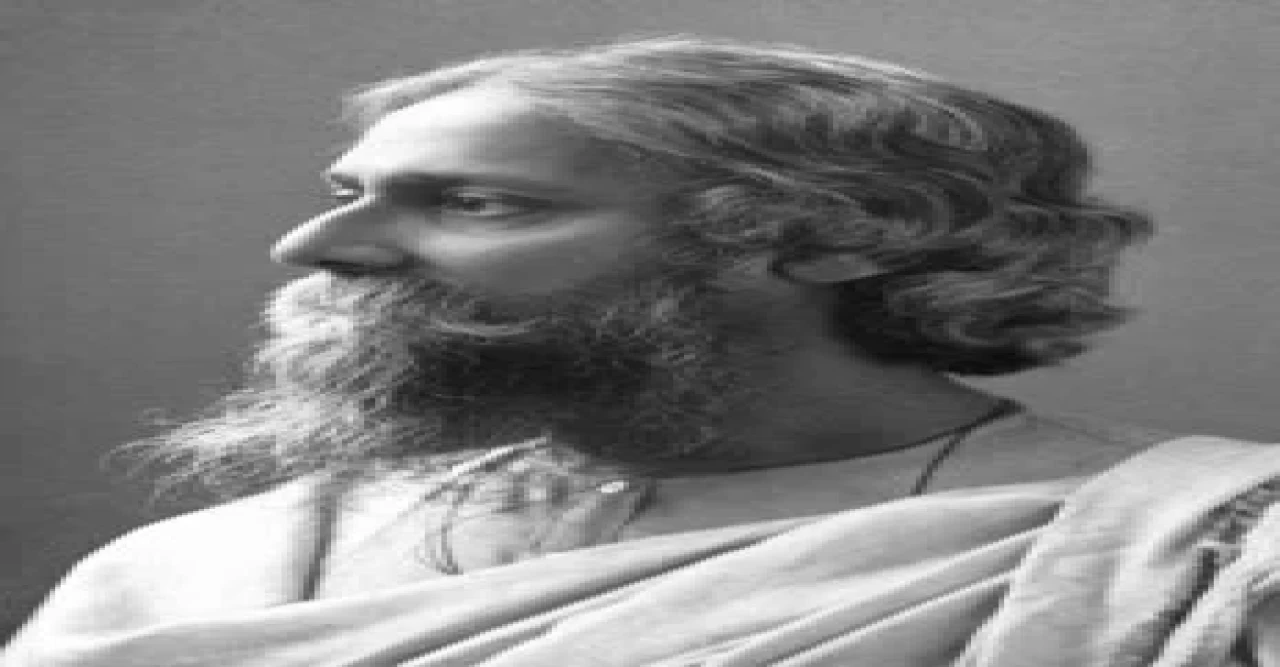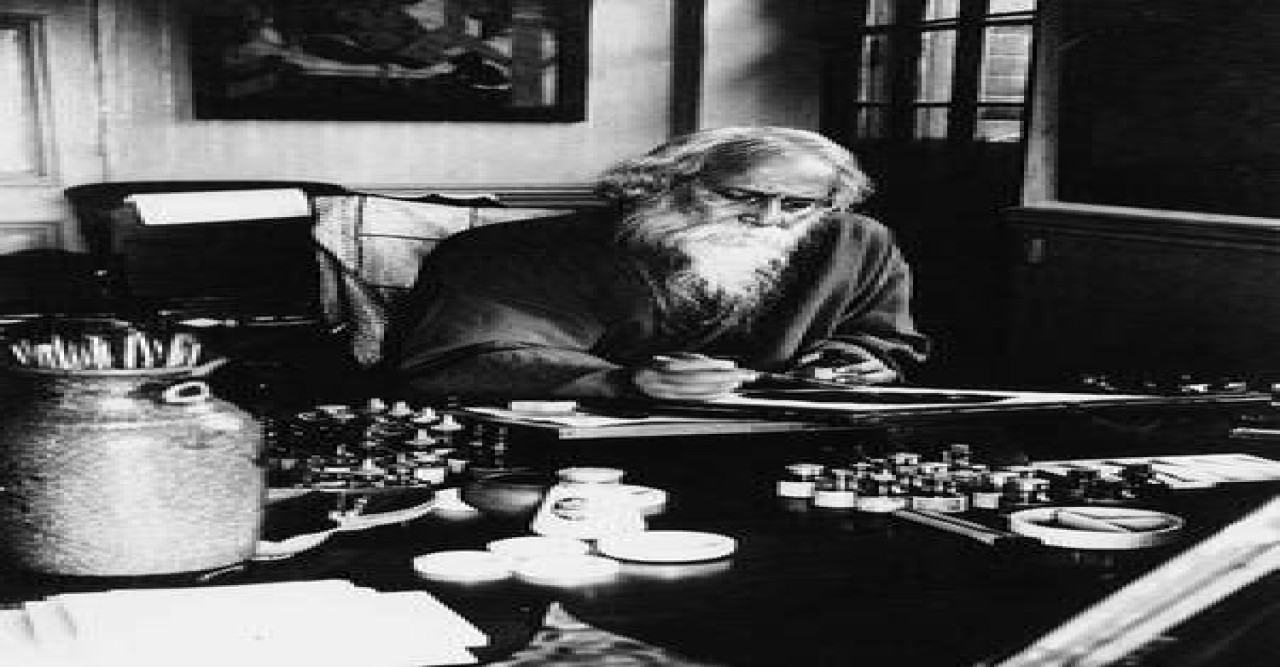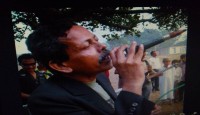"Taal gach ek paye dariye / On one leg stands the palm tree. Sob gach chariye / overshooting all trees. Uki mare aakashe /peeping over the sky." "Amader choto nodi chole bake bake Boishakh maashe tar hatu jol thake. Paar hoe jay goru, paar hoy gaari - Dui dhaar unchu taar, dhalu taar paari." "Our little river flows in graceful loops The summer heat dries her to a gentle flow, Both cart and cattle travel across with ease Her banks are high, her depths are shallow" (Tagore).
Recently I returned from Santiniketan winding up my Calcutta visit. Most of the historical places of India, museum, stations/junctions and memorial halls were built during the British India period. I visited a few universities/schools, including the University of Calcutta, where my father-in-law graduated in 1933. And the hotel, Aminia, where he loved to eat often. He often shared his memories of Calcutta with his family. I also met students at Santiniketan, visited the central library of the Viswa Bharati University, students' open class environment (a huge campus where children learn sitting under the trees (It is an abode of learning unlike any in the world), Santiniketan Museum and "Gitanjali" Railway Station Museum, Tagore's famous five houses he built and the Saloon Car/ train that carried Tagore for the last time (during his sickness). I visited a number of places such as Eco Park (The authorities made replicas of these world-famous structures and places, keeping children in mind. So they can learn about the seven wonders). I visited Rabindra Sadan, Calcutta, New Market, built by the British (it is a bit like Red Square and Gum, Russia), Victoria Memorial Hall, Indian Museum, Tagore's Ashram, Esplanade, Calcutta Metro, which is similar to the Toronto Subway system, Sealdah and Howrah, two big railway stations built by the British (on my way to Santiniketan), etc. Becoming part of an auspicious event gave me a blissful feeling. On January 18, 2018, I had the opportunity to join a Palm Tree planting event. Tagore wrote a wonderful poem sitting under a palm tree close to the bank of the Atrai River at Patisar, Naoga.
I visited a number of places such as Eco Park (The authorities made replicas of these world-famous structures and places, keeping children in mind. So they can learn about the seven wonders). I visited Rabindra Sadan, Calcutta, New Market, built by the British (it is a bit like Red Square and Gum, Russia), Victoria Memorial Hall, Indian Museum, Tagore's Ashram, Esplanade, Calcutta Metro, which is similar to the Toronto Subway system, Sealdah and Howrah, two big railway stations built by the British (on my way to Santiniketan), etc. Becoming part of an auspicious event gave me a blissful feeling. On January 18, 2018, I had the opportunity to join a Palm Tree planting event. Tagore wrote a wonderful poem sitting under a palm tree close to the bank of the Atrai River at Patisar, Naoga.
The palm tree died in 1966 due to a massive storm. Recently, the local people found the roots of the original palm tree and planned to plant another tree at the same spot. The day they decided to plant the palm tree, luckily, at the same moment, I was in Patisar for my own study purposes. The sub-district officer of Patisar, Naoga, somehow learned that I came to visit Tagore's secondary school, Kaligram Rathindranath School. He requested me to join the planting event and say a few words about Tagore and his education. Once again, the incident made me believe in the Cosmos. It is Cosmos that brought me to Patisar. We loved to recite those two sweet rhymes in our childhood. My professor Kathleen O'Connell, suggested observing the implications of science at Rathindranath School. She thought it would be fascinating to discover if those early efforts had had any later effect on the Patisar area. So I went to Patisar, Naoga, to visit Rathindranath School (the school was built after Tagore's son's name, a high school established at Patisar by Tagore). I am lucky that I was able to meet grade 10 students of Rathindranath School and visit the library, labs, etc. I finally reached my destination and study place, Tagore's Santiniketan School, Vishwa Varati. I recollect so many sweet memories during my four-month visit to Bangladesh and Santiniketan, India. I am glad that I was able to gain classroom experience and meet students and teachers of two schools, secular and religious. Tagore believed that science can be taught practically, using science for rural construction, teaching science connecting it to nature, and teaching can be done sitting under a tree, not always inside the four walls of a classroom and in a laboratory. Tagore's student-centred pedagogy is based on the concepts of holistic education, which is more inclusive.
I am lucky that I was able to meet grade 10 students of Rathindranath School and visit the library, labs, etc. I finally reached my destination and study place, Tagore's Santiniketan School, Vishwa Varati. I recollect so many sweet memories during my four-month visit to Bangladesh and Santiniketan, India. I am glad that I was able to gain classroom experience and meet students and teachers of two schools, secular and religious. Tagore believed that science can be taught practically, using science for rural construction, teaching science connecting it to nature, and teaching can be done sitting under a tree, not always inside the four walls of a classroom and in a laboratory. Tagore's student-centred pedagogy is based on the concepts of holistic education, which is more inclusive.
Tagore built a total of 600 full-free primary schools and three secondary schools in Bengal, the then British India. Tagore started building schools in Kaligram. He built Kaligram Ratidranath secondary school for disadvantaged rural students in Patisar, Naoga, Bangladesh. Tagore built schools on his own land, covering 230 square miles. He built 600 schools for 600 villages in East Bengal, now Bangladesh. It is unfortunate that Tagore's idea could not make any impact on Patisar students and its people. Yes, they know who Tagore is, as they have a small museum room in their school building, and there is the Patisar Museum, which is just beside the school. They learn to dance and take lessons on drama and recitation, but there is no use of science in everyday life lessons or implementation of the self-transformation idea to create a universal individual through Tagore's method of teaching.
The science laboratory is filled with the old kinds of stuff. There are minimum science apparatuses for students, and more learned teachers are needed. The villagers complained that this school lacks educated/ trained teachers. And the result of this school is low. They have also complained that the school governing body (made up of locals) needs to spend the income to benefit students and improve the school. In Bangladesh's context, Tagore's education philosophy is appropriate and useful because his teachings have influenced past Bengali scholars and the education system. Kaligram Ratindranath Secondary School is the only one that remains. I had the opportunity to visit this school during the end of my studies. It still has 1,000 Bighas of land (1 Bigha =33 decimals) under the management of Rabindranath Secondary School, which remains unused. The local musclemen/influential people with political connections grabbed the land and removed Hindu administrative people.
They are refusing to hand over this school and Tagore's land to the government of Bangladesh. This promising school is supposed to be among the top 20 schools in Bangladesh but ranks lowest because of the need for more governance. I wish the educators of Rajshahi University and the government would collaborate and discuss how they can make this a public school and recast the trustee board to make it an excellent administrative body. During the visit, I talked to the local people and the authority of Atrai. There is no initiative to develop Rathindranath Secondary School or build a Rabindranath Tagore University. The university inspired by Tagore's work must be started here, think the local people and intellectuals of Patisar, Naoga. I also think Rajshahi University can take an attempt to teach a course on Tagore at undergraduate, MS, and PhD levels. This is a heritage of Bangladesh but looks like a neglected ruin. On the other hand, Santiniketan looks astounding. It was in the news that the central government needed to pay more attention to appointing a Vice Principal over the last few years. I took a few pictures of the demonstration of 200 kinds of stuff at the Santiniketan campus. It is a disappointment concerning Patisar. The boys in my pictures look to be bright and engaging.
What a shame they aren't being given the support they need. Tagore would be most unhappy about the politicization that has taken place and the distortion of his vision. Rabindranath Tagore was primarily an educationist rather than a poet or a critical political thinker. Framing an educational model, he put emphasis on 'naturalism,' the method of nature. In education, freedom is the basic guiding force for inculcating interest within a student who will derive inspiration from nature to pursue any branch of knowledge he likes. The establishment of Shantiniketan fulfilled Tagore's desired educational goal. Tagore's education marked a novel blending of the ideas of the East and the West. The spiritualism of Indian philosophy and the progressive outlook of the Western people were blended together to give rise to an educational philosophy that marked its distinction from other educationists in India. Tagore envisaged that nature is the best teacher to the pupil. Nature will provide a student with the necessary situation to earn knowledge. No pressure should be exerted upon the student to learn anything. It is nature that will be the guiding force in inculcating the spirit of learning in a student's mind to pursue the education he likes. It will shape his behaviour and character.
Tagore established a new milestone for the first time in the education arena. He wanted to say goodbye to book-centred and exam-focused education. With boldness and firmness, he rejected a book-centred education for students. To him, it is not just to confine the minds of boys and girls to textbooks only. It will kill the natural instincts of a student and make him bookish. It will destroy his creative skills. So, students should be freed from the book-centred education and should be given a broader avenue for learning. Tagore championed the cause of freedom, which he wanted to implement in the field of education. With that object, he opened Santiniketan, Sri Niketan, and Brahmachari Ashram. Accordingly, he gave students free choice to develop their interests in any field they like. He explained freedom in three categories: freedom of heart, freedom of intellect, and freedom of will. He wanted to ensure freedom for the learners. Education imparted naturally will lead to the fulfillment of these three freedoms. One may pursue vocational education, intellectual education, or education in any branch of the arts.
According to Tagore, teaching should be practical and real but not artificial and theoretical. As a naturalist and practical learning promoter, Tagore emphasized the practicality of education. That will definitely increase a learner's creative skills. That creativity will bring perfection in the learning process, and the student will be a master in his own field, not a slave to mere theoretical knowledge into which one delves deep. Tagore attached great importance to the fine arts in his educational curriculum. To him, games, dance, music, drama, painting, etc. should form part of the educational process. Students should take an active part in these finer aspects of human life. For, these are essential to enriching the soul. In his words, "Speaking is for mankind and music for nature; speaking is clear and limited by its needs, whereas music is mystic and expressive for a romantic eagerness.
That is why speaking creates nearness between man and man, while music helps us identify ourselves with nature. When the harmonies of sounds are released with our expression, then speaking loses much of its limited significance, but on the contrary, getting together of the two muses had an all-pervading character". Tagore was aware of our country's rural poverty, so he wanted to eradicate it through education. The practical training imparted in different crafts to the students will make them skilled artisans in their field. By applying their education, they can remove the poverty of the rural masses, thereby helping in rural reconstruction. Patisar is not a safe place for many reasons. So, the local people advised me to leave the place before the sunset. I felt sad and returned immediately, but I did not relinquish thinking of what Tagore meant don't limit a child to your learning, for he was born in another time.











